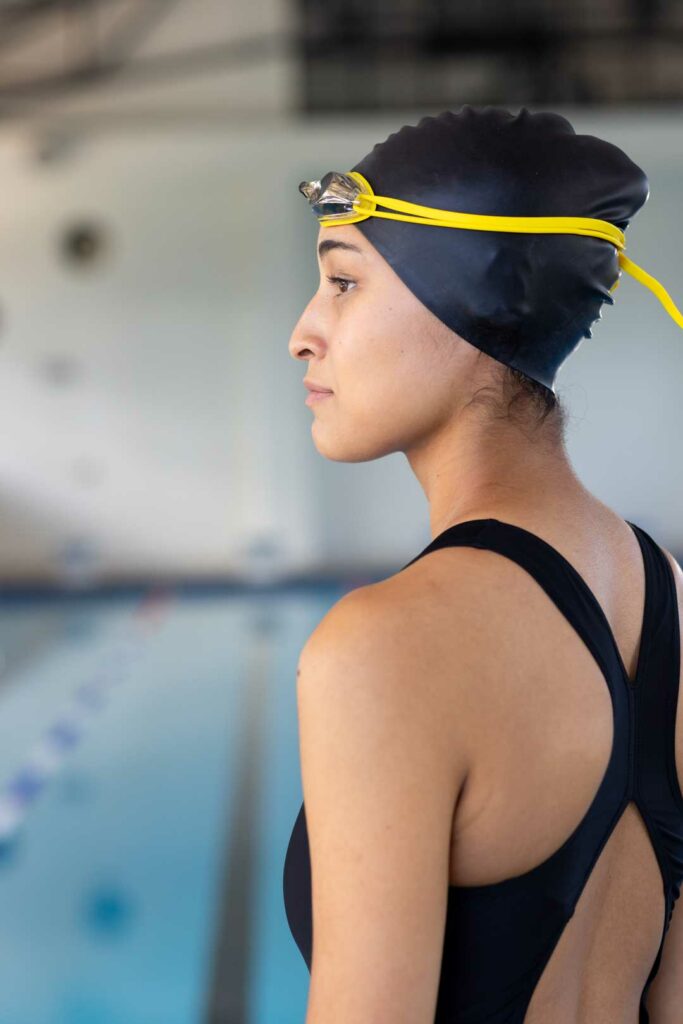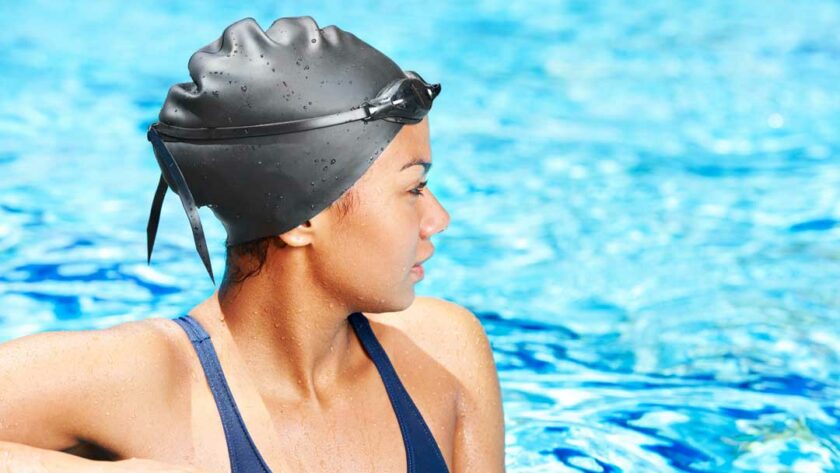Ever had a latex cap snap right before a meet? As a swim mom, I know that choosing a swim cap can make or break the day.
Choosing a swim cap can feel overwhelming, but it doesn’t have to be. As a former competitive swimmer and now a swim mom, I’ve tested them all.
The Swim Mom’s Guide to Choosing a Swim Cap That Works
The right cap boosts comfort, protects hair, and reduces stress on race day. Even beginners can benefit from finding the perfect fit. In this post, I’ll cover how to pick a swim cap, how to wear a swim cap, and when it’s truly necessary.
What Does a Swim Cap Do?
What does a swim cap do? A lot more than just keep hair dry (spoiler: it doesn’t actually keep it 100% dry). The purpose of a swim cap goes beyond appearance—it’s about performance, protection, and even safety.
Here’s why every swimmer benefits from a good cap:

- Reduces drag: A smooth, snug cap helps swimmers glide faster by minimizing resistance in the water.
- Protects hair from chlorine: It shields hair from harsh pool chemicals, reducing dryness and damage.
- Keeps hair out of the face: No more loose strands sticking to goggles or blocking vision mid-lap.
- Improves visibility: Brightly colored caps make swimmers easy to spot in crowded pools or open water.
- Helps retain body heat: In colder water, a cap keeps the head warm, which can make a big difference during long practices.
- Team spirit: Matching team caps create a united, professional look on race day.
Swim Mom Tip: I’ll never forget the meet where my daughter’s old latex cap snapped right before her heat. We switched to her backup silicone cap, and it fit like a dream—smooth, wrinkle-free, and distraction-free. She crushed her personal best in that race. Sometimes, the right cap truly sets the tone for success.
Is a Swim Cap Necessary?
Is a swim cap necessary? In most cases, yes—especially if your swimmer has long hair or is racing competitively. Many pools even require swim caps for hygiene reasons, as they help reduce loose hair in the filters and keep the water cleaner for everyone.
Even when not required, a swim cap can be a game-changer:
- Keeps hair manageable: No more tangled hair sticking to goggles or faces.
- Improves performance: A smooth cap reduces drag and helps swimmers feel faster in the water.
- Protects hair: It acts as a barrier against chlorine damage and sun exposure.
- Boosts confidence: Wearing a cap makes young swimmers look and feel like part of the team.
When is it essential?
- Competitive meets: A cap is practically non-negotiable for racing.
- Swimmers with long or thick hair: It keeps hair tucked away and prevents constant adjustments.
- Cold water or open-water swims: A cap helps retain heat and makes swimmers more visible.
Kids with short hair or casual swimmers may skip it for fun pool days, but even then, a good cap saves time and tangles.
Types of Swim Caps and When to Use Them
Wondering how to pick a swim cap? Each type of cap has its own perks and best uses. The right one depends on your swimmer’s needs, hair type, and whether it’s for daily practice or race day.
| Type | Best For | Pros | Cons |
|---|---|---|---|
| Latex | Practice and training | Affordable, lightweight, snug fit | Tears easily, can pull hair |
| Silicone | Meets and frequent swimmers | Durable, smooth, gentle on hair, wrinkle-free | Slightly pricier than latex |
| Lycra/Cloth | Casual swims or kids learning | Comfortable, easy to put on and remove | Not ideal for racing, lets water through |
| Thermal | Open water or cold pools | Retains heat, adds visibility | Bulkier, not designed for speed |
Swim Mom Recommendation
In our family, silicone caps win every time. They last longer, protect my daughter’s hair, and don’t leave her in tears when removing them after a tough practice. For meets, we always keep a backup silicone cap in her bag—because nothing derails race day faster than a last-minute cap tear.
How Should a Swim Cap Fit?
How should a swim cap fit? It should feel snug without being painfully tight. A properly fitted cap will sit smoothly on the head without wrinkles, gaps, or bulging areas. It should stay in place during starts, flip turns, and sprints, but it should never feel like it’s cutting off circulation.
Tips for Testing the Fit
- Stretch it gently: When putting it on, the cap should stretch without feeling like it will tear.
- Check for smoothness: Once on, it should lay flat against the head with no loose areas.
- Do the shake test: Have your swimmer shake their head—if it slips, it’s too loose.
- Measure head size: Some brands offer sizing guides. Use a soft tape measure around the widest part of the head to find the best size.
Adult vs. Youth Sizes

- Youth caps: Designed for smaller heads and thinner hair, often slightly less tight.
- Adult caps: Fit most teens and adults but can feel too big on younger kids.
Not all “one-size” caps are equal. Brands vary widely, so it’s worth trying a few to see what works best.
I learned the hard way that “one-size-fits-all” is a myth. At one meet, my daughter’s new cap looked great, but during warm-ups, it slid halfway off her head every turn. We had to scramble for a backup silicone youth cap, and the difference was night and day. Fit matters more than the color or logo!
Where to Get a Swim Cap That Lasts
Wondering where to get a swim cap that actually holds up? You have a few solid options, but not all caps are created equal.
Local swim shops are great for trying on different styles, while team stores often carry branded caps designed for competitive swimmers.
Amazon and other big online retailers work in a pinch, but my favorite go-to is SwimOutlet. They have every type of cap—latex, silicone, thermal—and the quality never disappoints.
Plus, I have a 20% off link for SwimOutlet, which is a lifesaver when you’re stocking up before a busy season of meets.
Why invest in a quality meet cap? Cheaper caps may seem fine for practice, but they tear easily and rarely last through multiple races. A well-made silicone cap not only fits better but also saves you from scrambling for replacements mid-season.
Swim Mom Tip: I always buy two of the same meet cap before championship season. Trust me—caps always sell out right before the big meets, and you don’t want to risk your swimmer racing in a random spare.
Choosing a Swim Cap That Stays Put (and Doesn’t Rip Hair Out!)
Choosing a swim cap may seem like a small decision, but it makes a big difference. The right cap improves comfort, protects hair, and even boosts confidence and performance. It’s one of those small pieces of gear that can save a lot of stress—both for swimmers and parents.
Every swimmer is different, so don’t be afraid to experiment with cap types and fits until you find the one that works best. Whether it’s a durable silicone cap for meets or a budget-friendly latex cap for practice, having the right gear helps your swimmer feel prepared and focused.
What’s your swimmer’s go-to cap? Share your favorite brands—or your funniest cap fails—in the comments below. I’d love to hear your stories!
FAQ: Swim Caps Made Simple
A swim cap reduces drag, keeps hair out of the face, and helps protect hair from chlorine damage. It also improves visibility and gives swimmers a polished, team-ready look.
A swim cap should feel snug but not painfully tight. It should lay flat against the head without wrinkles or gaps, and it shouldn’t slip during flip turns or starts.
While not always required, a swim cap is helpful for keeping hair out of the way, protecting it from chlorine, and making kids more visible to coaches and lifeguards.
Avoid sharp nails, hair clips, and forcing a too-small cap. Wetting hair first or using a small drop of conditioner can prevent pulling. Storing caps away from direct sunlight also helps them last longer.
Latex caps are lightweight, cheaper, and great for practice but tear more easily. Silicone caps are smoother, gentler on hair, and last longer, making them ideal for meets.






